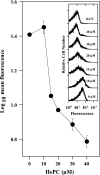Miltefosine (hexadecylphosphocholine) inhibits cytochrome c oxidase in Leishmania donovani promastigotes
- PMID: 17283192
- PMCID: PMC1855476
- DOI: 10.1128/AAC.01415-06
Miltefosine (hexadecylphosphocholine) inhibits cytochrome c oxidase in Leishmania donovani promastigotes
Abstract
Miltefosine (hexadecylphosphocholine [HePC]) is currently on trial as a first-choice, orally active drug for the treatment of visceral leishmaniasis when resistance to organic pentavalent antimonials becomes epidemic. However, data on the targets involved in its leishmanicidal mechanism have, until now, been only fragmentary. We have carried out a systematic study of the alterations induced on the bioenergetic metabolism of Leishmania donovani promastigotes by HePC. Overnight incubation with HePC caused a significant decline in the intracellular ATP levels of the parasites, together with a reduction in the oxygen consumption rate and mitochondrial depolarization, while the integrity of the plasma membrane remained undamaged. In a further step, the effects of HePC on the respiratory chain were addressed in digitonized parasites. The inhibition of the oxygen consumption rate caused by HePC was not reverted either with the uncoupling agent carbonyl cyanide p-trifluoromethoxyphenylhydrazone or with tetramethyl-p-phenylenediamine plus ascorbate, which feeds the electron transport chain at the level of cytochrome c. These results suggest that cytochrome c oxidase is a likely target in the complex leishmanicidal mechanism of HePC. This was further confirmed from the finding that this enzyme was specifically inhibited in a dose-dependent manner by HePC, but not the cytochrome c reductase, ruling out an unspecific effect of HePC on the respiratory chain.
Figures





Similar articles
-
Alteration of fatty acid and sterol metabolism in miltefosine-resistant Leishmania donovani promastigotes and consequences for drug-membrane interactions.Antimicrob Agents Chemother. 2005 Jul;49(7):2677-86. doi: 10.1128/AAC.49.7.2677-2686.2005. Antimicrob Agents Chemother. 2005. PMID: 15980336 Free PMC article.
-
Miltefosine affects lipid metabolism in Leishmania donovani promastigotes.Antimicrob Agents Chemother. 2007 Apr;51(4):1425-30. doi: 10.1128/AAC.01123-06. Epub 2007 Jan 22. Antimicrob Agents Chemother. 2007. PMID: 17242145 Free PMC article.
-
A mitochondrial HSP70 (HSPA9B) is linked to miltefosine resistance and stress response in Leishmania donovani.Parasit Vectors. 2016 Dec 1;9(1):621. doi: 10.1186/s13071-016-1904-8. Parasit Vectors. 2016. PMID: 27906059 Free PMC article.
-
Cellular transport and lipid interactions of miltefosine.Curr Drug Metab. 2009 Mar;10(3):247-55. doi: 10.2174/138920009787846332. Curr Drug Metab. 2009. PMID: 19442087 Review.
-
Orally effective drugs for kala-azar (visceral leishmaniasis): focus on miltefosine and sitamaquine.J Assoc Physicians India. 2003 Jul;51:686-90. J Assoc Physicians India. 2003. PMID: 14621038 Review.
Cited by
-
Functional Involvement of Leishmania donovani Tryparedoxin Peroxidases during Infection and Drug Treatment.Antimicrob Agents Chemother. 2017 Dec 21;62(1):e00806-17. doi: 10.1128/AAC.00806-17. Print 2018 Jan. Antimicrob Agents Chemother. 2017. PMID: 29061756 Free PMC article.
-
Dissecting Leishmania infantum Energy Metabolism - A Systems Perspective.PLoS One. 2015 Sep 14;10(9):e0137976. doi: 10.1371/journal.pone.0137976. eCollection 2015. PLoS One. 2015. PMID: 26367006 Free PMC article.
-
In Vitro and Ex Vivo Synergistic Effect of Pyrvinium Pamoate Combined with Miltefosine and Paromomycin against Leishmania.Trop Med Infect Dis. 2024 Jan 25;9(2):30. doi: 10.3390/tropicalmed9020030. Trop Med Infect Dis. 2024. PMID: 38393119 Free PMC article.
-
Oral Therapy with Amlodipine and Lacidipine, 1,4-Dihydropyridine Derivatives Showing Activity against Experimental Visceral Leishmaniasis.Antimicrob Agents Chemother. 2008 Jan;52(1):374-7. doi: 10.1128/AAC.00522-07. Epub 2007 Oct 22. Antimicrob Agents Chemother. 2008. PMID: 17954702 Free PMC article.
-
Lipid and fatty acid metabolism in trypanosomatids.Microb Cell. 2021 Oct 6;8(11):262-275. doi: 10.15698/mic2021.11.764. eCollection 2021 Nov 1. Microb Cell. 2021. PMID: 34782859 Free PMC article. Review.
References
-
- Alvar, J., S. Croft, and P. Olliaro. 2006. Chemotherapy in the treatment and control of leishmaniasis. Adv. Parasitol. 61:223-274. - PubMed
-
- Alvarez-Fortes, E., L. M. Ruiz-Perez, F. Bouillaud, E. Rial, and L. Rivas. 1998. Expression and regulation of mitochondrial uncoupling protein 1 from brown adipose tissue in Leishmania major promastigotes. Mol. Biochem. Parasitol. 93:191-202. - PubMed
-
- Antalik, M., D. Jancura, G. Palmer, and M. Fabian. 2005. A role for the protein in internal electron transfer to the catalytic center of cytochrome c oxidase. Biochemistry 44:14881-14889. - PubMed
Publication types
MeSH terms
Substances
LinkOut - more resources
Full Text Sources
Other Literature Sources

